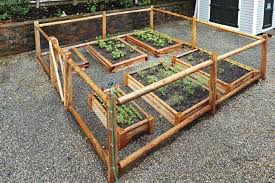Creating a beautiful and functional garden is often a labor of love. However, ensuring that your plants are safe from pests, weather extremes, and other threats can be challenging. This is where functional garden enclosures come into play. Not only do they protect your plants, but they can also add significant aesthetic value to your garden. Here are some inspiring ideas and practical tips for designing garden enclosures that marry beauty with functionality.
The Importance of Garden Enclosures
Garden enclosures serve multiple purposes that go beyond mere protection. They help define garden spaces, create microclimates, and even enhance the overall landscape design. By strategically placing enclosures, you can create secluded garden rooms, control plant growth, and keep unwanted animals at bay.
Types of Garden Enclosures
Fences
Fences are one of the most popular types of garden enclosures, offering both security and style. They come in various materials, including wood, vinyl, metal, and bamboo, each providing different benefits.
- Wooden Fences: These offer a classic, rustic look that blends seamlessly with natural landscapes. They can be stained or painted to match your garden’s aesthetic.
- Vinyl Fences: Low-maintenance and durable, vinyl fences are available in various styles and colors. They are perfect for those looking for long-lasting solutions without the need for frequent upkeep.
- Metal Fences: Materials like wrought iron or aluminum provide a sleek, modern look and are extremely durable. They can be customized with intricate designs to add an artistic touch to your garden.
- Bamboo Fences: Eco-friendly and exotic, bamboo fences are ideal for creating tropical or Asian-inspired gardens. They are lightweight yet sturdy and can last for years with proper care.
For professional assistance, consider consulting a company specializing in fence installation in Richmond to ensure your fence is both functional and aesthetically pleasing.
Trellises and Arbors
Trellises and arbors not only provide support for climbing plants but also add vertical interest to your garden. These structures can be made from wood, metal, or plastic and can range from simple designs to elaborate pieces of garden art.
- Trellises: Ideal for supporting vines like roses, clematis, and ivy. They can be standalone structures or attached to walls and fences.
- Arbors: Often used as entryways or focal points, arbors can be adorned with flowering vines to create a stunning visual impact.
Greenhouses and Cold Frames
For serious gardeners who want to extend their growing season or protect delicate plants, greenhouses and cold frames are excellent choices. These structures provide controlled environments that shield plants from extreme weather and pests.
- Greenhouses: Available in various sizes, from small portable units to large, permanent structures. They offer year-round protection and create ideal growing conditions for many types of plants.
- Cold Frames: Smaller and less expensive than greenhouses, cold frames are perfect for starting seedlings or protecting plants during cooler months. They can be easily constructed with materials like wood and old windows.
Netting and Row Covers
Inexpensive and easy to install, netting and row covers offer protection from pests, birds, and harsh weather conditions. They are particularly useful for vegetable gardens and delicate plants.
- Netting: Prevents birds and larger pests from accessing your plants. It can be draped over frames or directly over plants.
- Row Covers: Lightweight fabrics that protect plants from frost, insects, and sunburn. They allow air, light, and water to pass through while providing a protective barrier.
Designing Aesthetic Garden Enclosures
Harmonizing with Your Garden Style
When designing garden enclosures, it’s essential to consider the overall style of your garden. Choose materials and designs that complement your existing landscape features. For example, a rustic wooden fence would suit a cottage garden, while a sleek metal fence might be better suited for a modern, minimalist garden.
Adding Decorative Elements
Enhance the beauty of your garden enclosures by incorporating decorative elements such as:
- Finials and Post Caps: These can add a touch of elegance to fences and trellises.
- Paint and Stain: Use color to make your enclosures stand out or blend in, depending on your desired effect.
- Lighting: Solar-powered lights or string lights can highlight your enclosures and create a magical atmosphere at night.
Incorporating Plants
Integrate plants into your enclosures to soften their appearance and add greenery. Climbing plants, hanging baskets, and container gardens can all be used to beautify fences, trellises, and arbors.
Maintenance Tips
To ensure your garden enclosures remain functional and attractive, regular maintenance is essential. Here are some tips:
- Inspect for Damage: Regularly check for signs of wear and tear, such as loose posts, broken panels, or rust.
- Clean and Treat: Clean fences and structures periodically to remove dirt and algae. Treat wooden enclosures with sealants or stains to prevent rot.
- Prune Plants: Keep climbing plants and vines trimmed to prevent them from overwhelming your structures.
Conclusion
Functional garden enclosures are key to creating a beautiful and protected outdoor space. By choosing the right materials and designs, you can enhance the aesthetic appeal of your garden while safeguarding your plants. Whether you’re planning to work with a fence installation company in Richmond or embark on a DIY project, these ideas will help you achieve a perfect balance of beauty and functionality.






